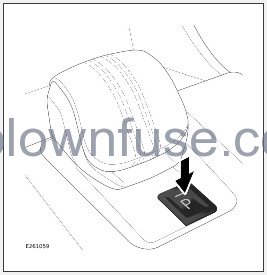2023 Land Rover New Range Rover Sport Brakes

ANTI-LOCK BRAKING SYSTEM (ABS)
The Anti-lock Braking System (ABS) on this vehicle does not create a pulsing sensation under heavy braking, unlike previous systems.
BRAKE SYSTEMS SAFETY
Make sure the following warnings have been read and fully understood. Failure to follow the guidance given could affect vehicle safety, leading to serious injury or death.
- If the red brake warning lamp illuminates, safely bring the vehicle to a stop, as quickly as possible, and seek qualified assistance.
- If the amber brake warning lamp illuminates, drive with care, avoid heavy brake pedal application, and seek qualified assistance.
- Do not rest a foot on the brake pedal while the vehicle is in motion. Doing so can damage the braking system and reduce braking efficiency.
- Do not drive if the message Brake fluid low is displayed. Check the brake fluid level and top up, as necessary. If necessary, seek qualified assistance before continuing.
- Never allow the vehicle to coast (freewheel) with the engine switched off. The engine must be running to provide full braking assistance. The brakes still function with the engine switched off, but far more brake pedal pressure is required to operate them.
- Never place non-approved floor matting or any other obstructions under the brake pedal. The result can be restricted pedal travel and reduced braking efficiency.
- Driving through heavy rain or water can have an adverse effect on braking efficiency. Under such circumstances, it is recommended to lightly apply the brakes intermittently, in order to dry the brakes.
- Do not pump the brake pedal at any time. Doing so interrupts the operation of the braking system and may increase stopping distances.
STEEP SLOPES
If the vehicle is stationary on a steep, slippery slope, it may begin to slide, even with the brakes applied. Without wheel rotation, the Anti-lock Braking System (ABS) cannot determine vehicle movement. To counteract this, briefly release the brake pedal, allowing wheel rotation. Re-apply the brake pedal to allow the ABS to gain control.
The vehcle needs to be in Neutral (N) or an appropriate gear to descend the slope. The Electric Parking Brake (EPB) must not be applied.
EMERGENCY BRAKE ASSIST (EBA)
If the brakes are rapidly applied, the Emergency Brake Assist (EBA) system automatically boosts the braking force to its maximum. The result is that the EBA system helps to bring the vehicle to a stop as quickly as possible.
The EBA system stops operating as soon as the brake pedal is released.
The amber brake warning lamp indicates an EBA system fault and the instrument panel displays a warning message. In this event, drive with care, avoiding heavy brake pedal application. Seek qualified assistance. See BRAKE (YELLOW).
ELECTRONIC BRAKE-FORCE DISTRIBUTION (EBD)
The Electronic Brake-force Distribution (EBD) system controls the balance of braking forces supplied to the front and rear wheels. The result is that the EBD system helps to maintain maximum braking efficiency and stability. If the vehicle has a light load, e.g., driver only and no luggage, the EBD system reduces the braking force applied to the rear wheels. If the vehicle is heavily laden, e.g., passengers and luggage, the EBD system increases the braking force to the rear wheels. The red brake warning lamp indicates an EBD system fault and the instrument panel displays a warning message. In this event, gently and safely stop the vehicle. Seek qualified assistance. See BRAKE (RED).
ELECTRIC PARKING BRAKE (EPB)
Do not rely on the Electric Parking Brake (EPB) to hold the vehicle stationary if the brake warning lamp is illuminated or the EPB warning lamp is flashing. Seek qualified assistance urgently. A faulty EPB system can lead to personal injury or death.
The EPB operates on the rear wheels, therefore, secure parking of the vehicle is dependent on being on a hard and stable surface. Operating the EPB on wet or loose surfaces may lead to damage to the vehicle or personal injury.
Do not rely on the EPB to operate effectively, if the rear wheels have been immersed in mud or water. Doing so may result in damage to the vehicle or personal injury.
Driving the vehicle with the EPB applied will cause serious damage to the braking system.

The EPB is integrated with the Park (P) button located on the center console.
When shifting from P with the EPB applied, the EPB automatically releases to allow a smooth drive away.
When the P button is pressed, the transmission engages Park (P) and the EPB applies to help secure the vehicle.
The EPB may be applied automatically by other vehicle functions.
When stationary, with the EPB applied and the transmission engaged in a forward or reverse gear, press the accelerator pedal gradually to release the EPB. The result is that the vehicle can be driven away smoothly. The driver’s door must be closed or the driver’s seat belt fastened to allow the EPB to release.
The EPB applies automatically if the ignition is switched off and the vehicle’s speed is below 2 mph (3 km/h).
The driver may wish to leave the vehicle secured by using transmission Park (P) only, e.g. in very cold environments.
To deactivate automatic operation of the EPB when the vehicle’s ignition is switched off, operate as follows:
- With the engine running, press the P button once to engage transmission Park (P) and apply the EPB.
- Press the brake pedal and simultaneously press the P button for 1 second. The EPB releases and transmission Park (P) remains engaged.
- Whilst still maintaining brake pedal pressed, switch off the ignition.
- Check that the vehicle is secured by transmission Park (P).
If an EPB fault is detected, the instrument panel displays a warning message. The amber brake warning lamp also illuminates. See BRAKE (YELLOW).
If a fault is detected during EPB operation, the instrument panel displays a warning message. The red EPB warning lamp also flashes. See BRAKE (RED).
In an emergency, press and hold the P button to apply the EPB and give a controlled reduction in the vehicle’s speed. The vehicle can also be brought to a complete stop. The vehicle must be traveling at more than 2 mph (3 km/h), and the accelerator pedal must also be released. The brake warning lamp flashes, a warning chime sounds, and the instrument panel displays a warning message. The stop lights illuminate. Release the P button, or press the accelerator pedal, to release the EPB.
To protect against unintentional vehicle movement, the EPB automatically applies when the driver is detected to be exiting the vehicle. The EPB is applied when Drive (D), Neutral (N), Reverse (R), or Sport (S) is selected and all of the following conditions exist:
- The vehicle is stationary.
- The driver’s door is opened.
- The brake pedal is released.
- If the driver exit EPB application feature is triggered while the driver’s seatbelt is unbuckled, the seatbelt must be buckled to allow drive-away release.
- The vehicle may move briefly before the EPB is applied.
- On a steep slope, the EPB does not apply if the vehicle’s speed is above 2 mph (3 km/h) when the brake pedal is released.
- If the EPB is released and the driver exit conditions are still met, the EPB automatically re-applies after a short period of time.
To exit the vehicle with the EPB released and the transmission in N, operate as follows:
- With the engine running, press the P button to engage transmission Park (P) and apply the EPB.
- Press the brake pedal and simultaneously press the P button for 1 second. The EPB releases and transmission Park (P) remains engaged.
- Whilst still maintaining brake pedal pressed, select N.
- Whilst still maintaining brake pedal pressed, switch the vehicle’s ignition off.
- Open the driver’s door and exit the vehicle.
BRAKE HOLD
The brake hold functions act on all four wheels. Under the specified conditions, the brake hold functions apply the Electric Parking Brake (EPB) automatically on the rear wheels only. On steep or slippery slopes, especially when facing downhill, applying the EPB may cause the vehicle to skid. Re-apply the brake pedal to secure the vehicle. Failure to do so may result in serious injury or death.
To avoid damage to the vehicle it is recommended to disable all brake hold functions when using an automated car wash that propels the vehicle. Failure to do so could cause damage to the vehicle.
Take care when using brake hold, there may be some vehicle movement while the function is active. There may be increased vehicle movement during a cold engine start when the idle speed is high. On slippery or loose surfaces such as gravel, there may be some wheel spin or skidding while the brake hold is active.
The brake hold functions maintain the vehicle in a standstill position without the brake pedal having to be pressed continuously.

When a brake hold function is active, the instrument panel illuminates the brake hold lamp.
The brake hold functions operate in Reverse (R), Neutral (N), Drive (D), and Sport (S). The brake hold maintains hydraulic brake pressure in the braking system until the accelerator pedal is applied.
The engine may auto-stop while the brake hold function is active. When driving away, there is a slight delay after the accelerator is pressed, while the engine restarts.
The brake hold functions release hydraulic brake pressure and apply the EPB and then deactivate if:
- The brake hold function has been active for more than 5 minutes.
- The driver’s seat belt is unbuckled while a brake hold function is active.
- The driver’s door is opened while a brake hold function is active.
The brake hold functions are unavailable if:
- The driver’s seat belt is unbuckled or the driver’s door is opened.
- If Park (P) is selected.
- The EPB is applied. See ELECTRIC PARKING BRAKE (EPB).
- Hill Descent Control (HDC) is active.
- All Terrain Progress Control (ATPC) is active and the vehicle is being driven downhill.
- Adaptive cruise control queue assist is active.
- The vehicle’s engine is switched off manually.
The brake hold functions do not operate if there is a fault with:
- Dynamic Stability Control (DSC).
- The braking system.
- The EPB system.
The auto hold function applies the brakes automatically to prevent the vehicle from rolling back downhill. The auto hold function also holds the vehicle on uphill or downhill slopes whenever it is brought to a stop using the brake pedal.
The auto hold function is unavailable if the vehicle is engaged in N or P.

To disable or re-enable auto hold, touch the vehicle controls icon on the touchscreen driver sidebar. See DRIVER SIDE BAR ICONS.
- Select DRIVE.
- Touch the Auto hold soft key.
To disable the auto hold function while it is holding the vehicle on the brakes, press the brake pedal and touch the Auto hold soft key.
To activate on-demand hold, the vehicle must be at a standstill and the driver must give the brake pedal a quick firm press. On-demand can be activated in any gear except P.
On-demand hold operates in R, N, D, and S and maintains hydraulic brake pressure in the braking system until the accelerator pedal is applied.
On-demand, the hold is still available when an auto hold has been disabled via the touchscreen.

